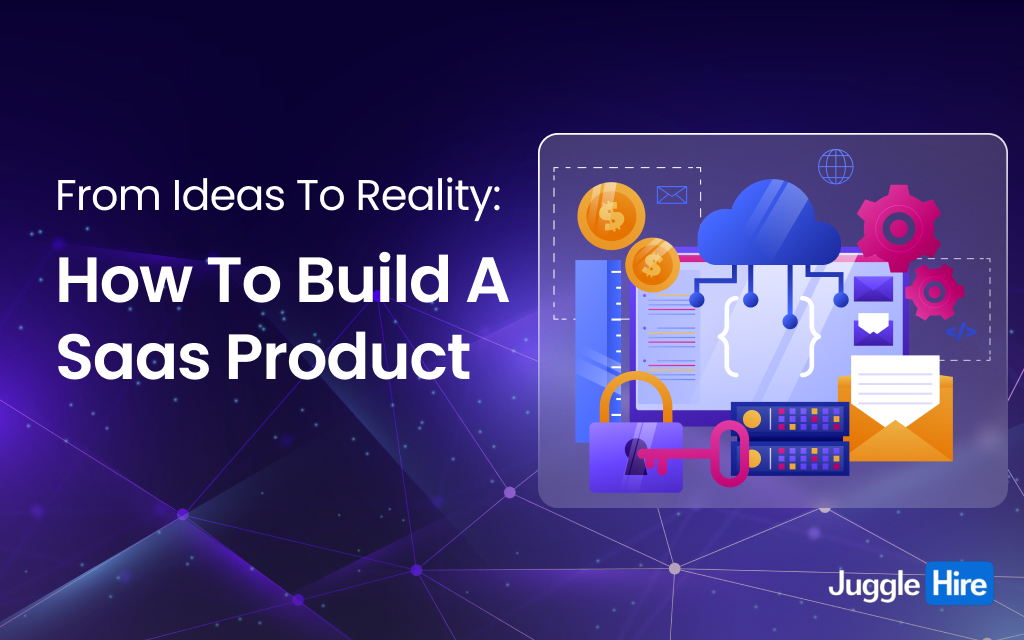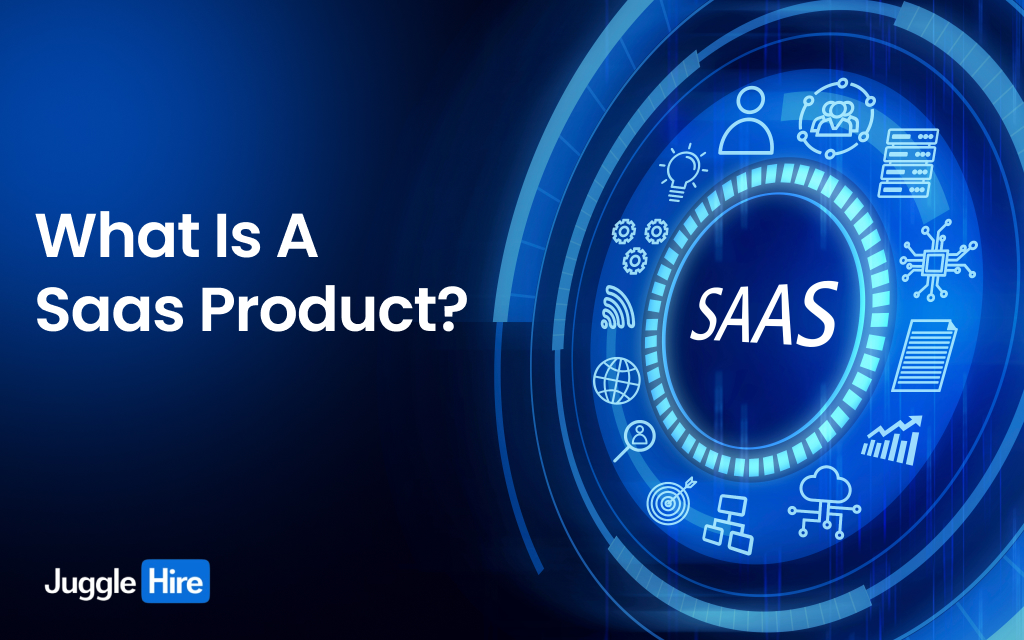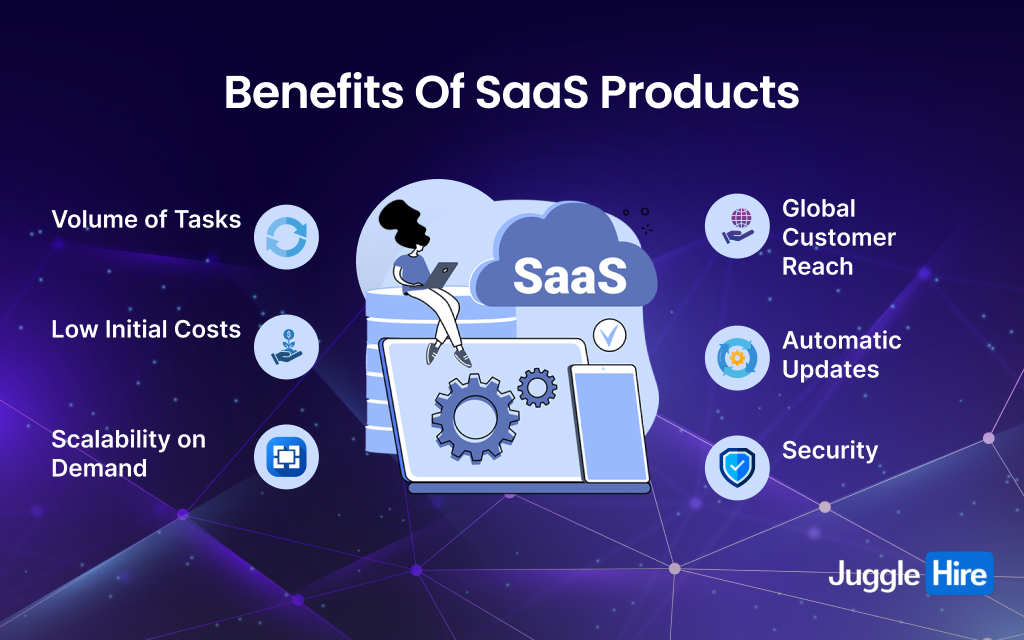How to Build a SaaS Product – 7 Tips to Turn Your Idea into Reality

Are you looking for the easiest ways to build your own SaaS product? If so, then you are in the right place. Today, we will show you how to build a SaaS product only in 7 steps.
According to Fortune Business Insight, the global SaaS market size is anticipated to surge from $273.55 billion last year to $1228.87 billion by 2032.
By now, you have realized the importance of building a SaaS product. If you’ve ever considered stepping into the realm of SaaS, now is your moment.
With a vast market poised for further expansion, launching a SaaS product could be your chance to transform how businesses operate across the globe. You could solve real problems with smart, scalable solutions.
As a SaaS development company, we are eager to share our extensive experience on how to build a saas product with you. Let’s dive into it!
What is a SaaS Product?

In contrast to the traditional licensing model, SaaS, or Software as a Service, is a cloud computing model that delivers applications over the web as a service. Users of the service are relieved from the need to install or maintain the software; instead, they simply access it via the Internet. This liberates them from the complexities of software and hardware management.
SaaS products, also known as web-based software or hosted software, operate on the servers of SaaS providers. Examples include Shopify and Netflix, which allow users access to their services without requiring any installation. The host site takes responsibility for all updates and subsequent maintenance. However, users may be charged on a subscription or pay-as-you-go basis to access these platforms.
Benefits of SaaS Products

There are a bunch of benefits that you can get from Saas products. Here is a list of all of them:
I) Recurring Income
SaaS products provide a consistent income stream through their subscription-based model, enabling businesses to plan effectively and invest in future growth.
II) Low Initial Costs
SaaS development eliminates the necessity for substantial investments in hardware and software infrastructure, simplifying product adoption for customers and lowering entry barriers.
III) Scalability on Demand
SaaS effortlessly scales to accommodate a growing user base without the need for significant infrastructure investments, particularly advantageous for startups and expanding businesses.
IV) Global Customer Reach
SaaS software’s accessibility from anywhere with an internet connection enables businesses to reach a wider market and extend their global presence.
V) Automatic Updates
SaaS providers automatically deploy updates and improvements to all users, ensuring continuous alignment with the latest features, security fixes, and bug repairs, eliminating the need for manual updates.
VI) Security
SaaS products benefit from centrally controlled hosting and regular security updates, mitigating risks of piracy and hacking. Moreover, subscription-based access acts as a deterrent against unauthorized copying by not granting access to the product.
Types of SaaS Applications
As the trend towards utilizing SaaS-modeled applications grows among companies and businesses, an array of SaaS applications emerges to address diverse industry needs. Explore the following categories of SaaS software:
1. CRM SaaS Software
CRM SaaS software, a cloud-based customer relationship management tool, enhances customer experiences regardless of location. It empowers companies to strengthen relationships, automate sales processes, and optimize marketing opportunities.
Popular CRM software includes Salesforce, Zendesk, Zoho, Pipedrive, Freshworks, Salesflare, Microsoft Dynamics, Hubspot, and more.
2. ERP SaaS Software
ERP, or Enterprise Resource Planning SaaS software, is a rapidly growing cloud-based solution for real-time business operations management.
It aids companies in planning, budgeting, forecasting, and documenting financial reports, covering areas like accounting, risk management, compliance, procurement, project management, shipping, and inventory management.
3. SaaS Collaboration Software
Cloud-based SaaS collaboration software enhances communication, organization, and collaboration among team members.
It facilitates brainstorming, project contribution, task organization and assignment, effective communication, and task progress tracking. Popular options include Slack, Workplace, Confluence, Figma, and more.
4. SaaS eCommerce Platform
SaaS eCommerce platforms provide online businesses the ability to establish online stores without substantial investments in web/app development and design.
Examples like Shopify allow entrepreneurs to create customized online shops, access premium features, and incorporate payment gateway integrations for online transactions. Other solutions include Bigcommerce and Volusion.
5. SaaS Project Management Software
Cloud-based SaaS project management software enables effective planning, allocation, scheduling, and management of projects or tasks. It fosters collaboration between team members and project managers.
Noteworthy options include Jira, Trello, Teamwork Project, ProofHub, Basecamp, and more.
7 Steps on How to Build a SaaS Product from Scratch

As we said earlier, we will show you how to build a SaaS product only in 7 steps. We have come to this segment. Now let’s get started with the first step!
Step 1: Conduct a Market Research
Distinguishing between promising SaaS application concepts and viable ideas requires thorough market research. Explore the dynamics of the specific niche you aim to serve to gain insights into its operation. During this phase, address the following inquiries:
- Define the vision of your business idea.
- Identify existing players in your niche and discern their unique qualities.
- Determine potential target users and their geographical locations.
- Identify specific needs users may have that current players overlook.
- Understand users’ challenges with existing SaaS products in the market.
- Outline how your product will offer solutions to these challenges.
- Identify essential features for your SaaS products.
- Analyze prevalent monetization strategies in your niche and assess their effectiveness.
Leverage the findings from your research to comprehend the current market landscape, allowing you to develop a product that effectively addresses user needs and penetrates the market.
Step 2: Develop a Robust Business Plan
In laying the foundation for your SaaS business, the efficacy of your business plan plays a pivotal role in navigating the path to success. Delve into critical aspects:
a) Unique Selling Point
Articulate a compelling narrative differentiating your SaaS product within the targeted business niche. Prioritize formulating a distinctive selling proposition before embarking on the actual development process.
b) Universal Value Proposition
Even within a market saturated with similar products, elucidate the unparalleled value your SaaS product brings to customers in your specific niche. Emphasize the distinctive features that set your offering apart.
c) Monetization Strategy
Crafting a viable revenue-generation strategy is paramount for the sustainability of your SaaS product. Explore nuanced monetization strategies without overlooking critical details:
(I) Freemium Model
This proves to be an effective strategy for onboarding users to your software. It involves granting users access to fundamental features with the option to upgrade for additional functionalities. The key is to provide users with specific benefits that compel them to transition to the paid model for enhanced advantages.
Shopify serves as a prime example of a SaaS company successfully employing this approach. Users can set up their distinctive online presence, by accessing Shopify features for a 14-day trial period.
Shopify strategically captivates users during this window, prompting them to upgrade to a paid package within two weeks to unlock further benefits.
(II) Flat Rate Pricing
You can implement a fixed-rate structure for access to specific features. Adopted by industry leaders like Adobe, Basecamp, Precog, and Consider.
(III) Pay as You Go Model
You can establish a usage-based pricing system, correlating the software’s value with actual usage. Implemented by industry players such as Chargify, ConvertKit, and SendGrid.
(IV) Tiered Pricing Model
You can diversify the service packages to cater to varying needs and financial capacities. Notable examples include HubSpot and Spotify, offering subscribers a range of choices based on their requirements.
(V) Per-User Model
You can also leverage a widely adopted pricing strategy, billing subscribers based on the number of users utilizing the SaaS software. Exemplified by ProductPlan, aligning pricing with user engagement.
(VI) Per Active User Pricing Model
A specialized variation of the per-user model, allows subscribers to opt for yearly subscriptions while billing them based on the number of actively engaged users. Noteworthy application in Slack’s pricing model, providing a balance between flexibility and value for users.
Step 3: Define Your SaaS Requirements
The intrinsic value your SaaS product offers to end-users is contingent upon its functionalities. While these functionalities vary based on the specific business niche, there are fundamental requirements common to standard SaaS Software.
To elucidate, let’s explore some core requirements:
a) Security Features
Given the cloud-based nature of SaaS software and the storage of substantial client data in cloud storage, implementing robust security measures is imperative. Include measures such as identity management, two-factor authentication, and access control to mitigate risks of malware or hacks.
b) User-Friendliness
SaaS applications excel in user-friendliness compared to on-premise apps. Ensure your SaaS application is customer-friendly by offering straightforward navigation, swift page load times, and an intuitive UI/UX design.
Avoid complex text blocks, excessive J.S. scripts, and CSS styles to maintain optimal speed, preventing high bounce rates and low conversion rates.
c) Real-time Support and Maintenance
Given the occasional occurrence of bugs and glitches in SaaS solutions, opt for packages that provide continuous customer assistance services. Proactive resolution of issues before they impact user experience is vital for maintaining user satisfaction.
d) Multi-tenancy Infrastructure
Implement a multi-tenancy infrastructure, where multiple businesses or tenants share a single SaaS installation platform. This model ensures the secure protection of end users’ and organizations’ data within the shared environment of your multi-tenant software architecture.
Also Read: Remote Hiring Tips: How To Attract, Hire and Retain Remote Employees
Step 4: Develop Your MVP
Following the identification of core requirements for your SaaS product, it is time to embark on developing your MVP, representing a minimal version of your grand idea. The concept of creating an MVP serves several crucial purposes in navigating your business niche:
a) Accumulate Feedback and Validate Ideas
Develop an MVP to gather firsthand data from early adopters, understanding their experiences with your product. This step is essential to verify if your users are eager to engage with your solution and to avoid investing significantly in an application that might not address users’ pain points effectively.
b) Test Your Monetization Strategy
You can utilize the MVP phase to experiment with various monetization strategies, identifying the most suitable fit for your SaaS solution.
c) Effectively Pitch Your Idea
If seeking funding, having an MVP is imperative. Investors can grasp the essence of your idea and observe how users interact with the solution, fostering a better understanding of its potential.
The purpose of developing an MVP extends beyond verifying SaaS product features; it involves validating the viability of your business model. Leverage your MVP to gather extensive user feedback, enabling strategic decision-making for successful penetration into your market niche.
Step 5: Choose a Good Tech Stack
The technological stack comprises computer languages, frameworks, and tools employed in software development. Today’s technology landscape provides an array of options, making the process of constructing a SaaS product and choosing a solution stack challenging.
Additionally, specific requirements for your software add complexity, making it challenging to recommend a singular framework that caters to all SaaS needs.
Nevertheless, this guide explores some top-tier tech stacks worth considering when embarking on the development of a SaaS product.
Here, in this step of your SaaS product development lifecycle, we delve into the technology stack for key components of a SaaS application:
a) Frontend of a SaaS
HTML5, CSS3, and JavaScript are the most crucial technologies for front-end development. Nevertheless, many frameworks lessen the physical input needed to build the SaaS’s front-end.
For example, bootstrap 5 significantly minimizes the amount of HTML input required. At the same time, the JavaScript ecosystem includes various frameworks such as React.js, Angular.js, Vue.js, and dozens more.
b) Backend of a SaaS
Selecting the backend stack for your SaaS solution involves considerations of databases, languages and frameworks, security, business logic, and other components.
c) Programming Languages and Frameworks
The most popular backend programming languages and frameworks are Python (Django, Flask), PHP (Laravel, Symphony), and JavaScript.
d) Server
Common choices for servers include Apache and Nginx, operating either on-premises or in cloud environments like AWS, Google Cloud, or Microsoft Azure.
e) Database
Options range from MySQL, Redis, MongoDB to PostgreSQL, covering a spectrum of NoSQL and SQL databases.
f) DevOps Tools
Essential for building Continuous Integration/Continuous Delivery pipelines (CI/CD), tools like Docker, Kubernetes, Jenkins, and others play a pivotal role.
Regardless of your choices, it’s imperative to opt for a tech stack that enjoys popularity and widespread acceptance within the industry.
Step 6: Set up a Development Team
Having navigated through the preliminary stages, the next critical step is to assemble a team of developers to initiate substantive work. There are three viable approaches:
a) Hire an In-House Developer
Employing a SaaS developer to join your team is an option. For efficient execution, consider securing a technical partner or CTO to aid in the effective hiring and management of the SaaS developer. However, this method is becoming less popular due to its perceived time and cost intensity.
b) Freelancer
While offering flexibility in location, time zone, and cultural differences, this approach presents its unique challenges. Remote work may make it challenging to closely oversee and control the development process.
Effective project management becomes pivotal to success. Platforms like Toptal, Upwork, Fiverr, and Freelancer are viable for sourcing freelance SaaS developers.
c) Independent Contractor Company
Alternatively, outsourcing the development of your SaaS application to an independent development firm is a strategic choice. By entrusting the SaaS product development process to experienced experts with a track record in building SaaS products, you gain access to a wealth of knowledge.
An independent development company, having tackled diverse tasks, possesses the expertise to handle complex requirements and deliver optimal results.
As industry leaders, we recommend opting for a software development company to bring your idea to fruition. Beyond crafting your SaaS app, such a company offers valuable consultancy services. Relying on their expert opinions can save you time and money by guiding you on essential elements needed for your SaaS solution.
Step 7: Develop, Test, Launch
This step is where your SaaS product comes to life. You’re bringing all your ideas together to create something that the market will welcome. Don’t wait until your SaaS solution is fully done to start looking for bugs and code issues.
Test it as you go along with development. It’s a good idea to work with an experienced software development company with Q.A. engineers who can do regular tests during development. Use synthetic testing to simulate how users interact with your solution. This helps catch and fix potential issues before they affect users.
Keep testing, maintaining, and improving your SaaS solution even after you’ve launched it. Real user monitoring is a great way to keep an eye on your SaaS application’s performance after deployment. It captures and analyzes how users interact with your SaaS application in real-time, helping you address issues quickly.
Also Read: What is An Applicant Tracking System- A Comprehensive Guide for Beginners
Case Study: Adobe’s Shift to SaaS
- Background:
Adobe, known for software like Photoshop, traditionally sold its products as expensive one-time purchases with infrequent updates.
- The Shift to SaaS:
In 2012, Adobe transitioned to a subscription model called Creative Cloud. Customers could now pay a monthly or annual fee to access Adobe’s software suite.
- Outcome:
Revenue Impact: Adobe’s recurring revenue model led to significant financial growth. By 2015, Adobe’s stock price had doubled compared to its pre-subscription levels. By 2020, it had increased nearly sevenfold.
Customer Base Expansion: The accessibility of the subscription model attracted a wider range of users. This includes freelancers and small businesses, leading to a substantial increase in the user base.
- Impact:
Adobe’s move to SaaS has become a standout example of successful adaptation in the tech industry, demonstrating how the subscription model can drive consistent revenue growth and expand market reach.
How to Build a SaaS Product – Final Thoughts
Software as a service is indeed an evolving sector in the IT industry, showing substantial potential for growth. While embarking on the journey to build a SaaS product might pose its challenges, this guide on how to build a Saas product serves as a valuable starting point, paving the way for a rewarding venture.
Remember, perseverance, continuous learning, and staying attuned to market dynamics are key ingredients for success in the dynamic realm of SaaS development. So, embrace the journey, learn from each step, and unlock the vast possibilities that the SaaS landscape has to offer.
